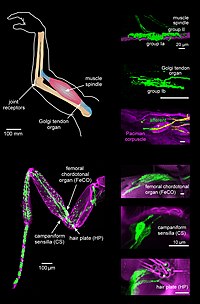
Photo from wikipedia
Humans excel at determining the shape and material of objects through touch. Drawing inspiration from this ability, we propose a robotic system that incorporates haptic sensing capability into its artificial… Click to show full abstract
Humans excel at determining the shape and material of objects through touch. Drawing inspiration from this ability, we propose a robotic system that incorporates haptic sensing capability into its artificial recognition system to jointly learn the shape and material types of an object. To achieve this, we employ a serially connected robotic arm and develop a supervised learning task that learns and classifies target surface geometry and material types using multivariate time-series data from joint torque sensors. Additionally, we propose a joint torque-to-position generation task to derive a one-dimensional surface profile based on torque measurements. Experimental results successfully validate the proposed torque-based classification and regression tasks, suggesting that a robotic system can employ haptic sensing (i.e., perceived force) from each joint to recognize material types and geometry, akin to human abilities.
Journal Title: IEEE transactions on haptics
Year Published: 2023
Link to full text (if available)
Share on Social Media: Sign Up to like & get
recommendations!